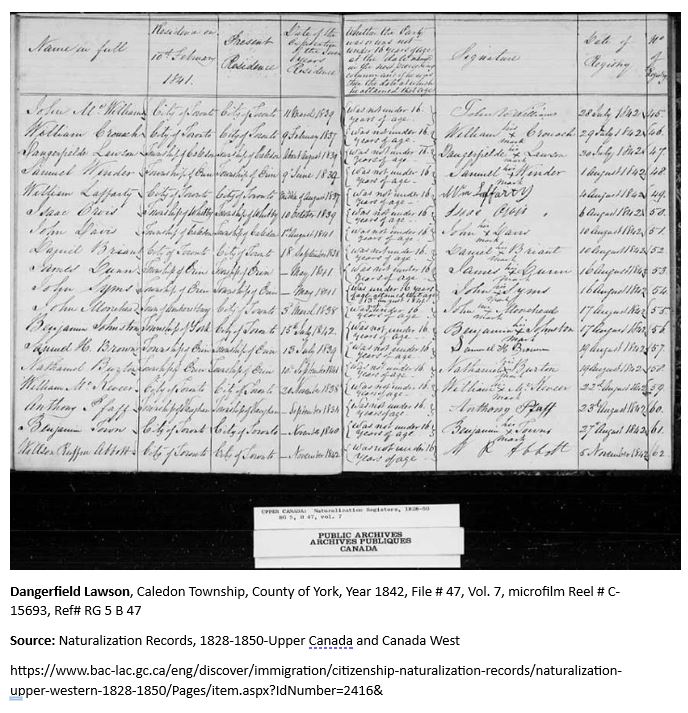
Date of Birth
1806
Place of Birth
Ghana, West Africa
Towns / Cities Moved Into
New Orleans, Louisiana, USA|
York County |
Peel Township Wellington County, Ontario Canada
Known Occupation
-
Religion
-
Spouse
Elizabeth Lawson
Death Information
Year of death
1861
Place of death
Queen's Bush, Peel Township, Ontario, Canada
Cause of death
-
Obituary

Parents

-

Klvia Lawson
Marital Status


Married Elizabeth Lawson
Children











Narrative / Story
Henry Dangerfield Lawson was born in the lush, vibrant land of Ghana, West Africa. It was a time when the region thrived with bustling markets, skilled artisans, and thriving agricultural communities. Ghana’s society was structured around intricate political systems, with chiefs and elders guiding their people through wisdom and tradition. Families lived in close-knit communities, their lives intertwined through deep-rooted kinship ties and cultural practices. However, this period was also marred by the harrowing impact of the transatlantic slave trade. Men, women, and children were brutally captured, torn from their homes, and shipped across the ocean.
The journey across the Atlantic, known as the Middle Passage, was a horrific ordeal for those enslaved. Packed tightly into the holds of slave ships, men, women, and children lay side by side, with barely enough room to move. The ships were designed for maximum efficiency, cramming as many bodies as possible into the confined space. Conditions were deplorable: the air was thick with the stench of sweat, vomit, and human waste, and diseases spread rapidly among the crowded ranks. The captives, shackled and unable to move freely, often lay in their own filth for the duration of the voyage. They had no idea where they were being taken or how long the journey would last, and the constant uncertainty added to their despair. Many spoke different languages and were unable to communicate, further deepening their sense of isolation and fear. Among these suffering souls was Henry Dangerfield Lawson, who, upon reaching the Americas, faced the grim reality of being sold into slavery, with conflicting accounts placing him either in Virginia or Hagerstown, Maryland.
At the tender age of 16, Dangerfield took a daring step towards liberty, embarking on a perilous escape from the shackles of slavery. During this attempt, he was tragically captured by his owner, enduring further hardship upon his return. Despite this setback, the failed escape demonstrated his unwavering resolve to seek freedom, no matter the considerable risks involved. In a gripping turn of events, Dangerfield later found himself in a life-and-death altercation with his captor. With remarkable courage, he fought back, eventually overpowering his oppressor by strangling him with a whip and escaping once more. To honor the abolitionist who assisted him in his flight to freedom, Henry adopted the surname Lawson, marking a new chapter in his life dedicated to liberation and resilience.
Following the North Star and meeting with abolitionists, Henry made his escape via the Underground Railroad to Canada West. His journey to freedom brought him into the path of abolitionists who stood firmly against the chains of slavery. With their invaluable assistance, Dangerfield made his way to the promised land of Canada, a beacon of hope and refuge for those seeking liberation from oppression. Arriving in 1844, he found a new home in Peel Township, an area known as the Queen’s Bush. This region became renowned for its welcoming embrace of freedom seekers, offering a safe haven where they could build new lives free from the tyranny of slavery. The Queen’s Bush community, composed of both Black and white settlers, provided a supportive and nurturing environment, embodying the spirit of solidarity and resilience in the face of oppression.
In 1842, while living in York County, he took the British oath of allegiance. In May 1844, he moved with his family to Peel Township, settling on the western half of lot 17, concession 7. The rugged terrain of Peel Township presented challenges, but he faced them with the same tenacity that guided him through the trials of his early life. The 1851 census lists Dangerfield as married, with Elizabeth Harris, being the only other person in their household.
Henry married Elizabeth, and together they had six sons and five daughters with between 1834 and 1860: Henry Dangerfield II, Mary, Molly Ann, William Henry, Ester, Samuel, Elizabeth, John, James, Ephriam, Mary Ann. His children later moved to Guelph, Ontario, continuing the family legacy. Henry Dangerfield Lawson is known as an early black settler in Wellington County. His family carried on his legacy as hardworking, reliable, and resilient members of their community.
Henry Dangerfield Lawson likely died before 1861, as he was no longer in the census. His death had certainly occurred prior to 1867, as the Elora Observer and Salem & Fergus Chronicle made references to him as one of the early settlers in Peel Township. His legacy lives on, with descendants like Ms. Melba Jewel, an influential figure in the black community in Wellington County, where many members of her family still reside.
Dangerfield’s story stands as a powerful reminder of the struggles faced by countless individuals who sought liberation during a tumultuous period in history. It is a tale of bravery in the face of adversity, of hope amidst despair, and of triumph over oppression. His life exemplifies the profound impact that the abolitionist movement had on shaping the destiny of those who dared to dream of a world free from the chains of slavery. Today, we remember and honor Dangerfield Lawson, a man whose extraordinary journey serves as a testament to the indomitable human spirit and the pursuit of freedom. His legacy continues to inspire and reminds us that even in the darkest moments, the flame of hope can burn brightly, leading us towards a brighter and more just future.




